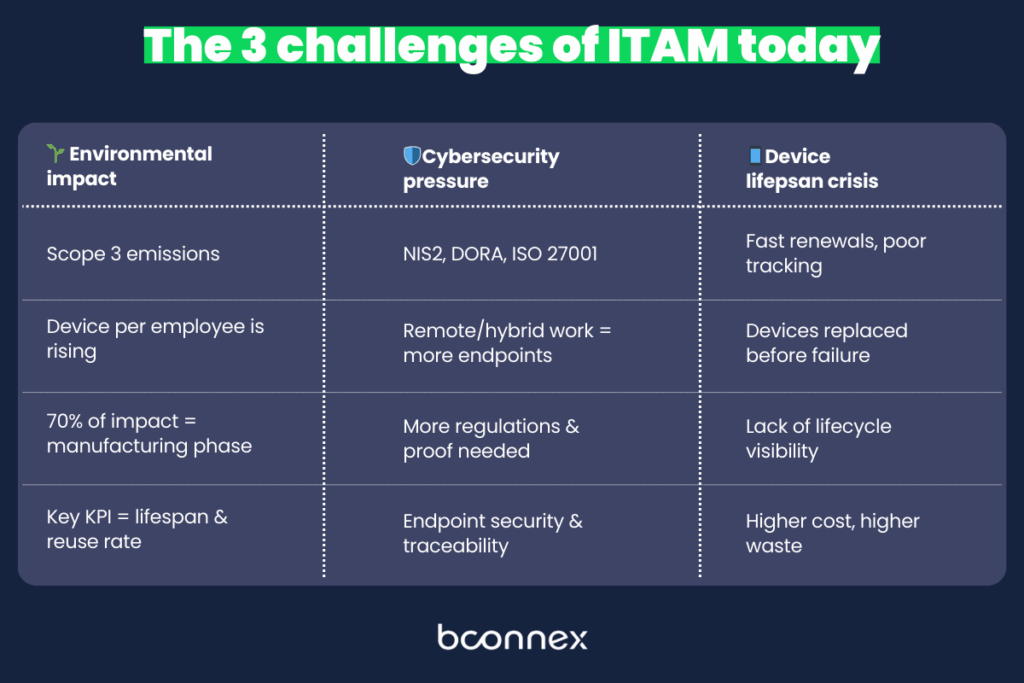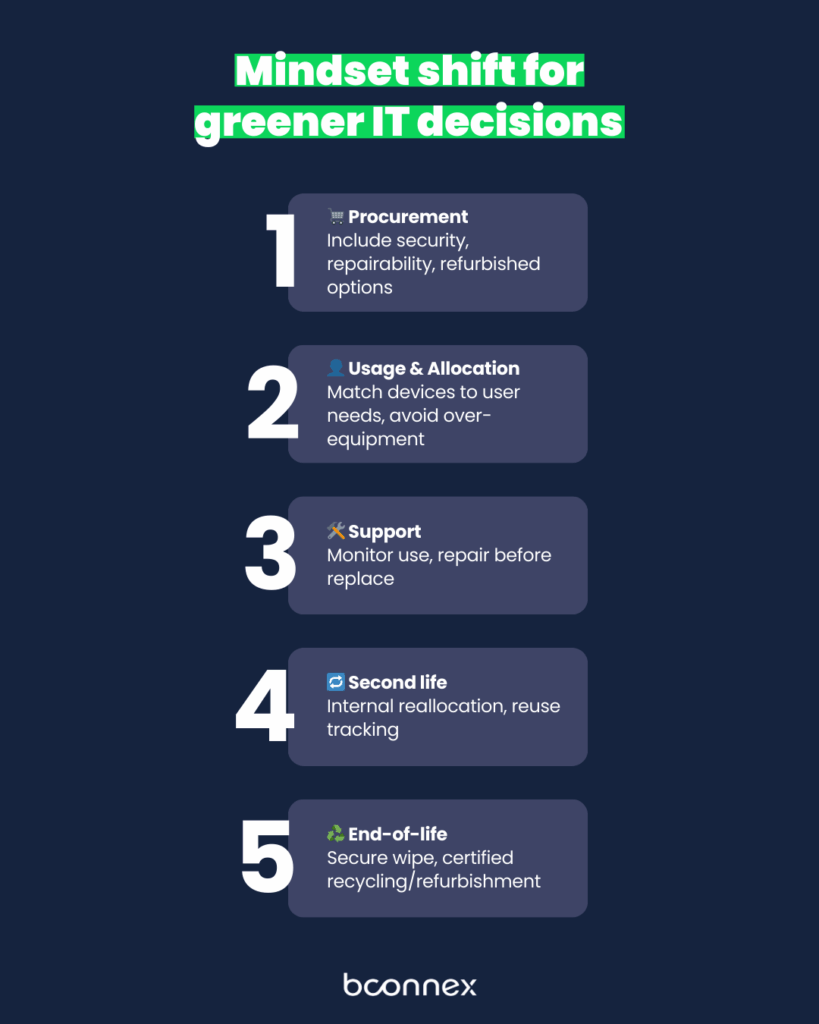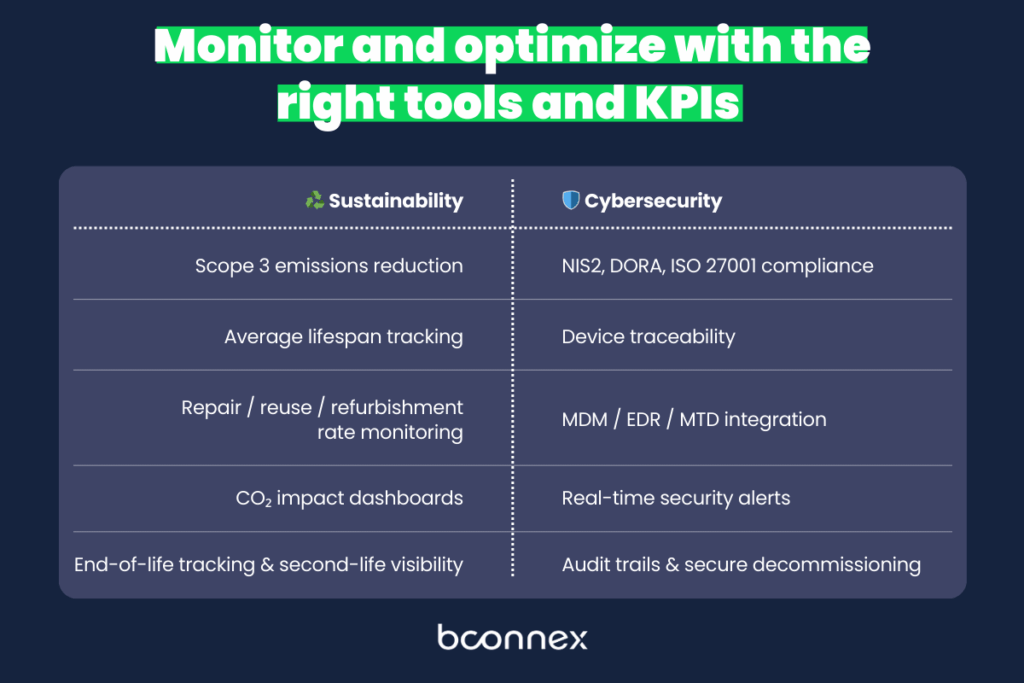2025 is a turning point for IT asset management (ITAM). With rising cyber risks, tighter regulations, and growing pressure to reduce emissions, ITAM is no longer just about keeping inventory in order: it's about building resilient, responsible infrastructures and workflows.
IT fleets represent a growing share of Scope 3 emissions. From production to logistics to end-of-life, every terminal has a carbon cost. And in many companies, the number of devices per employee is still increasing, boosting negative environmental impact even more.
At the same time, clients, investors, and regulatory bodies are pushing for transparency and measurable progress.
We are now in times where ITAM teams can no longer ignore questions like:
📊 According to the French Agency for Ecological Transition (ADEME), the environmental impact of a computer is 70% tied to its manufacturing phase. Extending its lifespan is one of the most effective ways to reduce digital carbon footprints (this includes reusing, repairing, and refurbishing).
As remote and hybrid work become the norm, cyberattacks multiply, and the number of devices per employee increases, unmanaged or misconfigured devices pose significant vulnerabilities. But the challenge isn’t only technical, it’s now also regulatory, and not only in the EU.
Between NIS2, DORA, and ISO 27001:2022, ITAM is officially in the scope of compliance. Therefore, organizations must nowadays:
And, as importantly, they must be able to prove it.
For a deeper dive into 2025's main regulatory frameworks (NIS2, DORA, ISO 27001), check out our dedicated article here.
As manufacturers release new models faster than ever, many devices are replaced not because they fail, but because they’re misconfigured, underutilized, poorly tracked, or even worse, because they’re simply not the latest model anymore.
Therefore, without accurate and well-managed lifecycle visibility, IT fleets become:
The result? Shorter device lifespans, higher costs, more emissions, and more gaps for cyber threats to exploit.

Given that digital sobriety is becoming a core CSR expectation, that cybersecurity threats are more complex and more regulated, and that devices are being renewed faster than ever, using tools that allow for a global vision of these aspects is essential. It’s what our mobilehub platform is built for. You can explore the platform through a demo or start with a free trial.
ITAM has long been seen as a technical support function. But currently facing tighter regulations and rising expectations from clients, employees, investors, and society, ITAM can no longer be limited to procurement and maintenance. Today, it’s a strategic function, and when managed sustainably, it becomes a powerful business lever.
Let’s break down the three main impacts of a well-executed ITAM strategy.
Sustainable ITAM isn’t just about reducing carbon emissions and electronic waste. It starts with visibility and control (of assets, data, and decisions).
Hence, with the right processes and tools, efficient IT asset management means:
This results in a leaner, smarter fleet, as well as a lighter administrative burden for IT and support teams. Fewer resources wasted, fewer support tickets, and better ROI across the IT fleet.
Security isn’t just about firewalls and passwords. It’s also about knowing what’s in your infrastructure. Because every device is a potential entry point, especially if it’s unknown, unmanaged, or outdated.
In that sense, robust ITAM plays a crucial role in:
And a resilient ITAM strategy is one that:
In short, there’s no effective cybersecurity strategy without robust asset management.
Sustainable IT isn’t just about repairing or recycling devices. It’s about rethinking how we manage them from end to end. And in ITAM, that means embedding sustainability into every step of the device lifecycle.
A responsible IT fleet management strategy must extend beyond basic maintenance. It should integrate environmental and security considerations from procurement to end-of-life.
A truly sustainable ITAM approach includes:
The right tool for IT fleet management can also be used to monitor:
This kind of visibility helps reduce environmental impact while improving cost-efficiency and compliance. This helps not only to do better for the planet, but also to unlock smarter, cleaner, and safer operations.

At bconnex, this is the philosophy behind everything we build. Our mobilehub platform is designed precisely to provide you with these insights about sustainability and cybersecurity, and to offer you a global view of your IT fleet. You can explore the platform through a demo or start with a free trial.
Companies are increasingly evaluated not just on what they do, but how they do it, whether in HR or IT, or even other departments. Thus, sustainable ITAM is also a reputational lever.
It is important to keep in mind that in many sectors, sustainable ITAM contributes to:
It's not only about reducing impact, it's about demonstrating that IT decisions are aligned with broader corporate responsibility goals.
In a context where clients, partners, and candidates pay increasing attention to values and transparency, ITAM becomes a key driver of corporate image.
The bottom line is that when managed properly, IT assets stop being “just devices”, they become a bridge between operational excellence, data protection, and environmental impact.
Sustainable and secure ITAM isn’t improvised. It requires structured processes, adapted tools, and clear indicators to track performance and impact. Here’s how to start building (or improving) your own strategy.
The first shift to make is to manage assets across their full lifecycle, not just during procurement or support phases. Every step counts, from purchase to daily use, from repair to reuse or recycling/refurbishing.
That means building your ITAM processes around 5 key phases:
To measure performance at each stage, the following indicators are essential:
These KPIs can then be used to support CSR reporting (Scope 3), IT budgeting, and hardware procurement decisions. They also contribute to aligning IT operations with broader ESG goals.
Looking for a partner across all phases? Contact us.
Looking for a tool to help monitor it all? Try mobilehub.
Security must be embedded in every ITAM action, especially in 2025, where compliance and cyber-resilience are now expected.
A secure-by-design ITAM strategy involves:
And as of 2024–2025, three major frameworks now explicitly include ITAM:
Cybersecurity is now a strategic requirement and priority for all sectors. The NIS2 directive and DORA regulations impose strict obligations, including on IT service providers. ISO 27001 (even in the EU) and GDPR remain essential pillars for structuring cyber resilience.
The bottom line is that organizations must now secure their devices and be able to prove how they do it.
At bconnex, we are committed to this dynamic, in particular with:
Contact us if you are in need of a cybersecurity partner for your IT fleet.
Finally, responsible ITAM is a living system. It needs to be monitored, optimized, and adjusted over time.
With the right platform, organizations can:

In short, the right tool won’t just track devices, it will help you manage your fleet better, whether from the point of view of devices, users, sustainability, or cybersecurity.
mobilehub gives you a centralized, strategic view of your IT fleet, with the data and tools you need to manage assets in a smarter, greener way, and more securely. Try it for free or book a guided demo.
In 2025, responsible IT asset management is no longer a nice-to-have but a necessity. What’s at stake? ROI, compliance, cybersecurity, and a company’s reputation as a responsible employer and service provider.
Yet many organizations still treat ITAM as a set of one-off tasks: order, allocate, replace, dispose. However, in today’s landscape, that’s no longer enough.
Sustainable ITAM is a continuous journey, not a checklist. It’s about anticipating needs, extending device value, and aligning operations with long-term goals, from carbon reduction to data and user protection.
So how do you move from intention to action?
From our experience at bconnex, the companies that succeed in building sustainable IT workflows are those that don’t wait for regulations or emergencies. They invest in visibility, culture, and alignment, and make digital responsibility a shared goal.
The future of ITAM lies in convergence between tools, teams, and values. It’s time to stop managing assets in silos and start building smarter, greener, safer infrastructures.
In 2025, it’s the final call to integrate simple but powerful dual indicators: security and environmental impact.